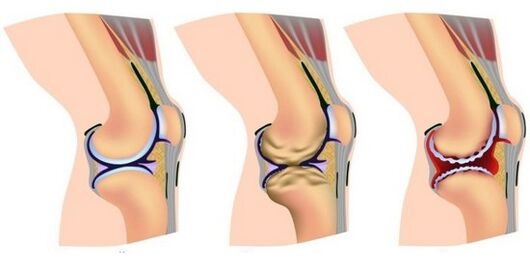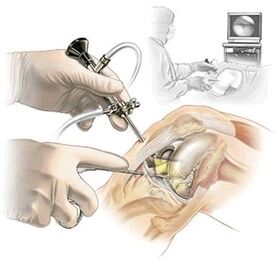
Knee pain is one of the most common unpleasant sensations experienced by everyone at least once. The development of the disease, which is caused by the pain that may appear, is due to the fact that the human knee is composed of many structures, and every day they are all subjected to very large loads. Damage can affect one of the ligaments or tendons, or certain sacs that are filled with fluid, as well as cartilage. These symptoms can be a signal of a disease not only related to the knee, but also a general disease of the body or system.
It is also necessary to distinguish with what movement pain occurs, for example, pain in the knee during flexion is inherent in people who lead an active lifestyle, and often talk about violations of the structure of joints and bones. Such cramps mainly appear in the final stages of the course of the disease, when it is impossible to do without treatment with the help of surgical intervention. Often the knee is sore and crunchy when squatting, this may indicate that cartilage tissue is being erased (especially observed in athletes due to constant running). Pain on the inside arises due to various joint pathologies or the occurrence of neoplasms. The appearance of postpartum pain is due to the fact that during pregnancy, a woman's body undergoes many changes, which can lead to the development of several diseases.
It is important to determine why pain in the knee joint is expressed, as some diseases can be cured only with the help of manageable interventions, and for some it will be sufficient to use traditional medicine.
Etiology
As mentioned above, there are many reasons why a knee hurts, and it is not always directly related to injuries, illnesses and bruises on the knee joint. The first group of factors consists of disorders that directly affect the knee joint, among them are:
- Gonarthrosis is the most common disorder affecting people over forty. Pathology usually affects both knees. The main symptoms are pain and throbbing during extension and squatting. The cramps are sharp and sharp. The intensity level decreases when lying down;
- getting blood into the joint cavity;
- damage to the meniscus can occur at any age, regardless of gender. Often only one knee is affected. The disease is characterized by manifestations of strong dryness and pain in the knee when bending or after running. In addition, a person loses the ability to move, as he experiences unbearable pain at the slightest movement of the foot;
- arthritis - the disorder develops rapidly, the inflammatory process spreads to the knee joints of both legs. It is best to start treatment as early as possible as the disease has spread to other joints;
- violation of ligament integrity due to rupture, often the internal ligament is exposed to this, the more rarely it occurs on the side. In this case, there is swelling and limitation of motor function;
- various tendon inflammation - the appearance of which is caused by many causes, for example, infectious diseases or the influence of bacteria, trauma or bruising, allergies to drugs or abnormalities in the structure of the body. In such disorders, pain in the knee from within is expressed;
- displacement or dislocation of the patella - occurs very rarely and especially in children or athletes, after strenuous exercise or running;
- inflammatory processes in the articular bag. In case of untimely treatment, complications may arise, which should be eliminated only with the help of medical intervention;
- pathological processes in the synovial membrane covering the joints;
- the occurrence of cysts on the inside of the knee joint leads to pain below the knee in the back;
- destruction of the integrity of the adipose tissue covering the joints. Externally, this manifests itself in the form of swelling of the injured knee;
- osteoarthritis, in which cartilage tissue becomes thinner;
- various infectious diseases, the course of which can lead to arthritis. Pain in the knee is expressed during walking, as well as after squatting;
- bone tuberculosis;
- spinal pathology causes the feeling that the knee hurts when walking;
- metabolic disorders or salt deposition in the knee often cause pain in the knee when squatting.

The second group of causes consists of other influences from which pain in the knee joint arises:
- overweight;
- external injuries or bruises to the knee joint;
- work conditions that cause a person to have to stand for several hours in a row;
- intense physical activity - which is why this disorder is most often observed in professional athletes, for example, after running;
- incorrect posture while working;
- wearing uncomfortable high -heeled shoes.
There are several reasons why a woman's knee hurts during pregnancy:
- weight gain (in some cases up to twenty kilograms);
- lack of calcium and other minerals in the body;
- production of certain hormones that soften ligament tissue.
After childbirth, all unpleasant sensations should disappear by themselves, but if this does not happen, you should see a doctor, as this may serve as a sign of the above disease. After childbirth, a woman may experience knee pain when squatting, standing and stretching. This is due to the following reasons:
- intensive muscle work during childbirth;
- inadvertent sudden movements during the birth of a baby can cause dislocation;
- if a woman has various diseases of the musculoskeletal system before childbirth;
- when breastfeeding, fluid accumulates in the woman's body, which adversely affects the joints, as this is a pain when getting up and extending the knee.
symptoms
In addition to the obvious signs-pain of varying intensity and throbbing when squatting, this manifestation has additional symptoms characteristic of the disease, which causes sore knees when walking or other leg movements:
- sleep disorders;
- increased body temperature;
- decrease or complete lack of appetite;
- stiffness of movement;
- increased pain when walking. There was a significant increase in sitting or lying position;
- significant swelling of the injured knee - can be observed from the inside;
- inability to transfer weight to aching limbs;
- deformity of the patella;
- changes in skin color on the knees;
- fever.
When expressing the first signs, you must immediately contact a medical institution for diagnostics and appointment of effective treatment.
Diagnostics
Since many disorders give rise to the fact that the knee hurts when walking, after running, when squatting and standing, the diagnosis should consist of:

- a detailed survey of the patient for the appearance of the first symptoms, the intensity of pain, the place of its appearance (from outside or inside), possible causes (e. g. , during walking, after running or childbirth), which caused the pain;
- palpation of the knee by the attending physician to find out a more complete picture of the localization of pain, as well as to identify swelling;
- patient blood analysis for general and biochemical research;
- radiography - in which any structural pathology of the knee will be clearly visible;
- fluid sampling by puncture - carried out if the attending physician suspects bone tuberculosis;
- fluid puncture from the knee joint;
- arthroscopy - performed in cases of meniscus injury that causes pain in the knee from the inside. This method is carried out not only for diagnosis, but also during treatment;
- measuring bone tissue density;
- Ultrasound of the knee;
- examination of the patient using MRI and CT.
Treatment
There is no one way to cure all diseases and disorders. The method of treatment for each patient is set individually and depends on the cause of the appearance and severity of cramps, if the knee hurts while walking, after running, while squatting or standing. Methods of treatment prescribed to all patients without exception, including postpartum women:
- reduce the load on the lower part of the foot, so that no symptoms arise at all;
- the imposition of a fixation bandage on the injured knee;
- warm the knee with a warming ointment or compress. As prescribed by a physician, cold compresses are applied, but not more than fifteen minutes a day;
- anti-inflammatory drugs.
If necessary, treatment is carried out with surgical intervention.
In addition, there are alternative therapies that can reduce the onset of symptoms, but they can only be used after consulting a doctor. Treatment for such pain includes:
- iodine mesh;
- compresses from your own urine;
- mix raw potatoes with kerosene;
- apple cider vinegar lotion mixed with egg yolk;
- ointment of chopped potatoes with horseradish;
- onion compress, for this you need to cut it in half and apply in half on the outside and inside of the knee;
- cologne and dandelion solutions;
- tincture of elecampane root and alcohol;
- compresses of black elderberry, chamomile and pine cake;
- lotion from calendula;
- a mixture of mustard and honey.
Folk remedies are not recommended for women during pregnancy and after childbirth, when the baby is breastfeeding.
Prophylaxis
To avoid knee pain while walking, after running or squatting, you need to:
- adhere to a healthy lifestyle;
- constantly monitor your posture;
- make sure your weight is normal;
- warm up the muscles before exercise, so that knee cramps do not occur after running and exercising;
- wear only comfortable shoes;
- immediately treat all diseases that can lead to this disorder;
- undergo routine check -ups at the clinic several times a year;
- perform gymnastics if a person's lifestyle or work conditions are in a standing or sitting position;
- avoid hypothermia;
- at the first symptom, especially after childbirth or running, seek medical advice.




























